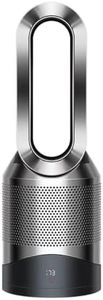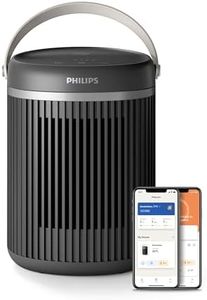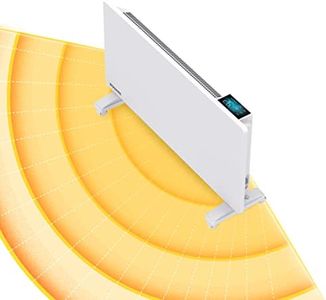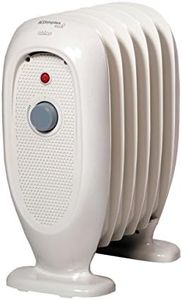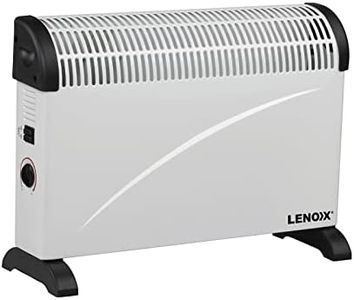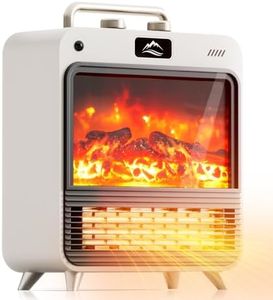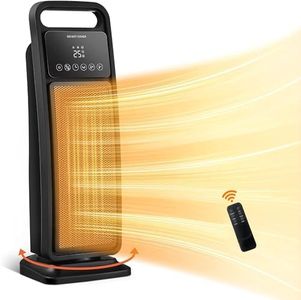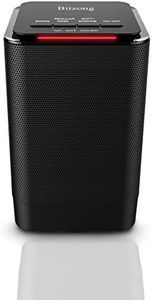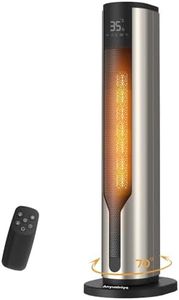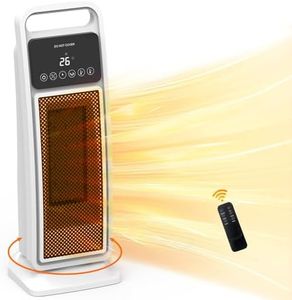We Use CookiesWe use cookies to enhance the security, performance,
functionality and for analytical and promotional activities. By continuing to browse this site you
are agreeing to our privacy policy
10 Best Safe Space Heaters For Baby Room
From leading brands and best sellers available on the web.Buying Guide for the Best Safe Space Heaters For Baby Room
Choosing a safe space heater for a baby's room is all about balancing safety, comfort, and efficiency. A baby’s room requires a heater that maintains a steady, comfortable temperature without risk of burns, tipping over, or causing dry air. When shopping, pay special attention to features intended to protect little ones and avoid models that get overly hot to the touch or produce loud noises. Focus on ease of use, reliable safety features, and how well the heater fits the size of your nursery.Safety CertificationsSafety certifications show that a heater has been tested and meets established safety standards for home use. Look for marks from agencies such as UL or ETL, as these indicate the heater's electrical and mechanical safety. Heaters without these certifications could pose risks like electrical shocks or fires. Always choose a heater that clearly displays a reputable safety certification for peace of mind.
Cool-Touch ExteriorA cool-touch exterior means the surfaces of the heater won’t get hot enough to cause burns, even after running for hours. This is crucial in a nursery since babies and young children can be curious and may accidentally touch the heater. Some heaters use special materials or have insulated casings. If the nursery is small and the heater might be within reach, always select a heater with this feature for safety.
Tip-Over and Overheat ProtectionTip-over protection means the heater will automatically shut off if it’s knocked over, while overheat protection turns the heater off if it gets too hot. Both features are essential with children around, as accidental bumps or malfunctions can happen. Not all heaters have both, so always check the product description or ask. Use these features to make sure your heater won’t continue operating dangerously if things go wrong.
Adjustable Thermostat and Temperature SettingsAn adjustable thermostat lets you set and maintain a specific temperature in the room, which is important for a baby’s comfort and safety since overheating or chilling can disturb sleep. Heaters can have analog dials or digital settings—some only offer fixed heat settings (like low or high), while others let you specify exact degrees. For nurseries, look for a heater that allows precise temperature adjustment to avoid swings between warm and cold.
Noise LevelsSome heaters can produce noticeable sounds, like fan whirring or clicking as they cycle. While older children and adults might not mind, babies can be sensitive to noise when sleeping. Noise levels are sometimes measured in decibels, but many products just list 'quiet operation.' If you’re trying to preserve a peaceful sleeping environment, focus on models specifically labeled as ‘silent’ or ‘whisper-quiet.’
Heating Method (Ceramic, Oil-Filled, Infrared, Fan-Forced)Heaters use different methods to warm the air. Ceramic heaters heat up quickly and often have cool exteriors, oil-filled heaters radiate steady heat but take longer to warm up, and infrared heaters provide warmth similar to sunlight. Fan-forced heaters heat up rooms quickly but can be noisier. For nurseries, ceramic and oil-filled models are most popular due to their safe surfaces and steady heat. Choose based on your needs for fast heat, safety, and noise.
Room Size CompatibilityNot all space heaters are designed for the same room sizes. Heaters typically list the square footage they can warm efficiently, such as 'up to 150 sq. ft.' If you use a too-small heater, the room won’t stay warm; too large, and it may use unnecessary electricity. Measure your nursery and select a heater whose recommended coverage matches your space for effective, balanced heating.
Humidifying FeaturesSpace heaters can dry the air, which may cause discomfort for babies (like dry skin or stuffy noses). Some models have built-in humidifying features or, at the least, materials that keep air from getting too dry. If your baby seems uncomfortable or you live in a dry climate, consider a heater that helps maintain healthy humidity levels or plan to use a separate humidifier.
Timer and Remote ControlA timer lets you program the heater to turn on or off automatically, and a remote adds convenience especially during nights when you don’t want to disturb your baby. Timers are helpful for overnight use so you don’t need to remember to switch the heater off. Consider these extras if you value convenience and want to maintain a consistent temperature with less hassle.
